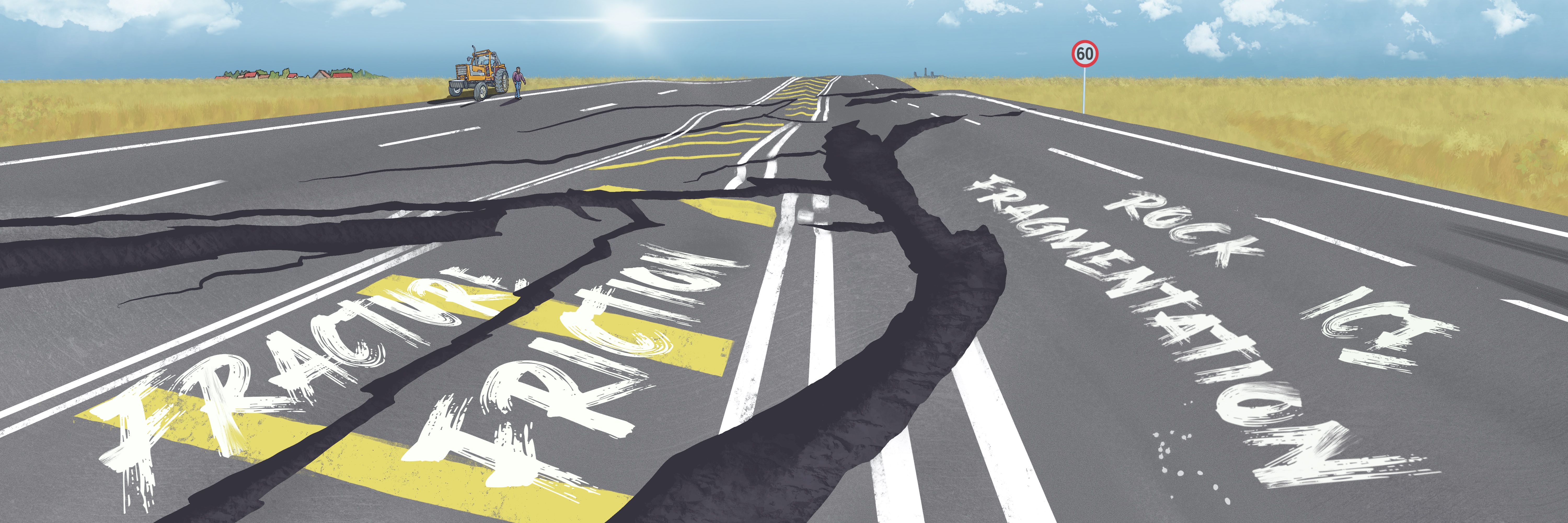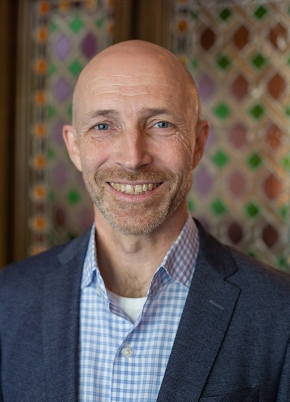FricFrac: A year of friction and fractures at CAS
The FricFrac project's research sheds light on the dynamics of geohazards, providing new understanding of landslides, earthquakes, and glacier surges.

The project has explored the complex dynamics of fractures and friction and how these deformation processes influence geohazards. By addressing a range of questions, the research has provided new insights into both solid earth geohazards, such as landslides and earthquakes, and ice hazards, like glacier surges. We talked to project leaders François Renard and Anders Malthe-Sørenssen about the project's key research questions, scientific advancements, interdisciplinary collaborations, exciting artistic outputs, and the future plans of the research team.

‘Friction and Fracture and the Onset of Geohazards’
The primary research questions of the FricFrac project focused on understanding the similarities and differences between solid earth geohazards and ice hazards. The team aimed to investigate how water pressure influences these instabilities. They got a great start to their research stay at CAS with fieldwork in Svalbard, which was crucial for gathering data to compare the mechanisms of friction in rocks and ice, from atomic scales to field scales. By processing field data from glaciers and employing state-of-the-art modeling techniques, the team sought to explain observed behaviors. The team also developed new experimental protocols for imaging laboratory earthquakes in four dimensions, shedding light on the preparation process of earthquakes and their damaging effect on rocks during earthquake propagation. Machine learning advancements were also leveraged to simulate friction more effectively.
One of the most significant advancements of the FricFrac project has been identifying similarities between the mechanics of glaciers in the Alps and Svalbard. This finding highlighted the limitations of current hydrology models of subglacial water flow. The team explains that, ”existing models account for water-filled cavities and underground rivers but fail to consider free water stored in the ice volume, which is hydraulically isolated from these rivers and cavities”. This oversight has implications not only for glacier modeling but also for understanding the role of water in earthquakes. The project also revealed that current earthquake models do not adequately account for the impact of water at depth, indicating a need for more comprehensive models.
Artistic Outputs
In addition to scientific research, the FricFrac project produced two exciting artistic outputs, collaborating with artists to create art prints and a comic book. Artist Ellen Karin Mæhlum accompanied the team in the field and contributed to the discussions, integrating artistic observation with scientific inquiry. The result was a series of art prints that capture the essence of the research.
The comic book, aimed at children, was another creative output. Illustrated by Knut Bauer, a long-time collaborator, the comic sought to make science fun and engaging for young audiences. "We didn't want to make it too science-heavy but fun and entertaining for younger school children," the team explained. The comic was written and translated by experts in geoscience and glaciology, ensuring scientific accuracy while maintaining an entertaining narrative. The team plans to have several copies in English printed in June, and a Norwegian version ready in September.

Interdisciplinary Collaboration in Geosciences and Physics
The FricFrac project was inherently interdisciplinary, involving experts in geology, glaciology, and physics. “This diverse team allowed us to bring together people with skills in numerical modeling, fieldwork, and laboratory experiments” as the team explained. The collaborative environment facilitated the development of new research directions and experimental methods. Bringing together specialists from the Alpine and Svalbard glacier research communities, who typically operate separate from one another, offered a unique opportunity for dialogue and collaboration. By fostering discussions on the differences between glaciers in the Alps and the Arctic, these experts can share insights, compare methodologies, and enhance our overall understanding of glacial dynamics across diverse environments.
The extended time spent together at CAS was crucial for building these interdisciplinary relationships. "Having significant and sufficient time is important when you want to establish this type of collaboration," the team noted. "It takes time to learn each other's problems and to learn languages, even within geosciences, where there are different problems and different languages."
Contributions of the CAS Environment
The supportive and collaborative environment at CAS significantly contributed to the project's success. The team produced around ten publications, with more expected in the coming years. Notable achievements include a review paper on pore fluid effects in faults and earthquakes, and substantial progress in understanding subglacial hydrology.
CAS facilitated connections with the University of Oslo (UiO) through regular seminars and collaborative events. The involvement of two artists resulted in unique outreach materials, further broadening the project's impact and outreach. The relaxed atmosphere at CAS allowed researchers to focus on important scientific questions without the usual distractions. "CAS is a free space to work on important research topics and to think and focus on quality," the team emphasized. This environment enabled them to address critical scientific questions and develop long-term collaborations.
Future Plans
As the FricFrac project concludes its academic year at CAS, the team is already looking ahead to future research and practical implementations. Plans include co-supervising PhD students, organizing research visits, and writing joint research proposals. The findings from this year will also be used in future funding applications to the Research Council of Norway.
The project also hosted a large final conference at the Norwegian Academy of Science and Letters, bringing together around 60 participants from various prestigious institutions. This event underscored the project's outreach and impact in the field, and the collaborative spirit fostered at CAS.
Reflecting on their time at CAS, the team noted that “perhaps the most important outcome is that we could focus on very important scientific questions and new questions, which I would not have had time to do if I was at the university."
It has been a pleasure to host the FricFrac project here at CAS for the past academic year. As the team continues to build on their findings, the future of the FricFrac project promises to be as dynamic and impactful as the geological events it studies.